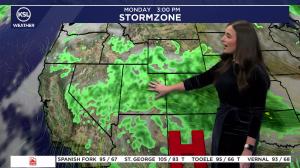Estimated read time: 4-5 minutes
PROVO — At least two of Utah's largest cities are looking into adjusting how their residents pay for water, utilizing a new state law.
Members of the Provo City Council discussed a new ordinance that would increase water rates by 5%, with recommended future increases that will be evaluated and voted upon each year. The council also proposed changing billing to a tiered structure for usage by type and meter size rather than the current seasonal rates.
The Salt Lake City Public Utilities Department is proposing similar changes for its service area, which includes Utah's capital and a few other cities near it. The department first unveiled a proposed water usage rate change in January that would also charge residents at higher rates the more they consume water.
"They will also see the volumetric charge be different and because of that — if they're more efficient — they'll save money on their overall bill," said Laura Briefer, the department's director.
Those changes could go into effect in July, pending final approval from the Salt Lake City Council, which is expected to vote on the matter within the next few months as it finalizes the department's budget.
Both measures are being considered just before HB274 goes into law. The bill allows cities to tier water rates, which could create a financial incentive for people to reduce their water consumption, Rep. Casey Snider, R-Paradise, the bill's sponsor, explained as it went through the legislative process earlier this year.
He said it could help Utahns understand the "true cost of water" consumption, which isn't the case now since many districts collect property taxes to cover most costs before charging low consumption rates.
"It treats water like ... a utility," he told colleagues on the House floor in February. "Think of what the world would be like if the person that left their lights on all the time paid the same price as the person who had one light bulb in their home. That basic lack of fairness would result in a skewed market — and that's what we have in water right now."
There are some exclusions, such as those who participate in urban agriculture. The bill goes into effect on May 7, tacking the new language onto existing law that aims to have secondary water sources metered by 2030.
University of Utah researchers project that Utah — now home to 3.5 million people — could gain about 2 million more people over the next 35 years based on recent growth trends. Given that the state is often prone to drought, lawmakers hope that drastic changes to rates can help conserve what the state has.
"This is a tough conversation at times, but until we start treating water like other utilities in our state, our state can't continue to sustain the growth that we're currently experiencing," said Rep. Bridger Bolinder, R-Grantsville.
The new rates in Provo would produce revenue for operation and maintenance costs, which have increased due to inflation, and to address replacement and repairs of the aging water system.
The proposed rate increase was initially much steeper, starting at a 12% increase with an eight-year plan of additional hikes between 6% and 8% to bring funding up to the recommended investment level, city staff said. After a February meeting where the Provo City Council and the public voiced concerns about the sharp change, city staff reevaluated all infrastructure funding to create a more balanced approach to the increases.
The new plan, proposed Tuesday, does not front-load the increases but still gets the city to the sustainable investment level, consultant Keith Larson said. The rate would increase by 5% starting in September. City staff recommended a plan of increases between 4% and 8% throughout the next decade, but the council would be responsible for evaluating the additional increases each year.
In the tiered system, residents would be charged additional money per thousand gallons used in varying price tiers on top of the base rate. The first tier would cover the average household's essential indoor uses, and the second tier would cover typical outdoor water use, Larson said.
"More expensive water will be charged at a higher rate and less expensive water will be charged at its actual rate, and it creates a fairer cost structure," added Gary Calder, Provo's water resource director.
While all Provo residents would see the across-the-board 5% base increase, the average water user would not see a significant change by shifting to the tiered structure, city staff said. Council members emphasized the importance of including an exception for those conducting urban gardening and expressed concern over vegetation dying if people cannot afford to water their plants.
Provo City Councilman George Handley said he thinks the change is the "right thing to do" and a "positive step forward." The City Council is expected to vote on the ordinance on April 22.















